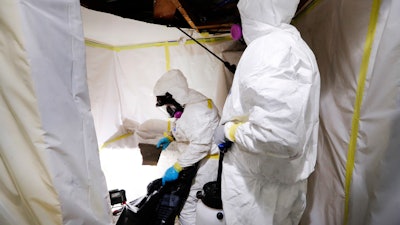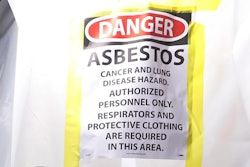
BILLINGS, Mont. (AP) — Spurred by the chemical industry, President Donald Trump's administration is retreating from a congressionally mandated review of some of the most dangerous chemicals in public use: millions of tons of asbestos, flame retardants and other toxins in homes, offices and industrial plants across the United States.
Read: The 10 Chemicals the EPA is Reviewing
Instead of following President Barack Obama's proposal to look at chemicals already in widespread use that result in some of the most common exposures, the new administration wants to limit the review to products still being manufactured and entering the marketplace.
For asbestos, that means gauging the risks from just a few hundred tons of the material imported annually while excluding almost all of the estimated 8.9 million tons (8.1 million metric tons) of asbestos-containing products that the U.S. Geological Survey said entered the marketplace between 1970 and 2016.
Lawmakers say the review was intended to be the first step toward enacting new regulations needed to protect the public. But critics - including health workers, consumer advocates, members of Congress and environmental groups - contend ignoring products already in use undermines that goal.
The administration's stance is the latest example of Trump siding with industry. In this case, firefighters and construction workers say the move jeopardizes their health.
Both groups risk harm from asbestos because of its historical popularity in construction materials ranging from roofing and flooring tiles to insulation used in tens of millions of homes. Most of the insulation came from a mine in a Montana town that's been declared a U.S. Environmental Protection Agency Superfund site and where hundreds of people have died from asbestos exposure.
"Hundreds of thousands of firefighters are going to be affected by this. It is by far the biggest hazard we have out there," said Patrick Morrison, assistant general president for health and safety at the International Association of Fire Fighters. "My God, these are not just firefighters at risk. There are people that live in these structures and don't know the danger of asbestos."
Asbestos fibers can become deadly when disturbed in a fire or during remodeling, lodging in the lungs and causing problems including mesothelioma, a form of cancer. The material's dangers have long been recognized. But a 1989 attempt to ban most asbestos products was overturned by a federal court, and it remains in widespread use.
The National Institute for Occupational Safety and Health analyzed cancer-related deaths among 30,000 firefighters from Chicago, Philadelphia and San Francisco. The 2015 study concluded firefighters contract mesothelioma at twice the rate of other U.S. residents.
Firefighters also face exposure to flame retardants included in the EPA's review that are used in furniture and other products.
"I believe the chemical industry is killing firefighters," said Tony Stefani, a former San Francisco fireman who retired in 2003 after 28 years when diagnosed with cancer he believes resulted from exposure to chemicals in the pending review.
Stefani said he was one of five in his station to contract cancer in a short period. Three later died, while Stefani had a kidney removed and endured a year of treatment before being declared cancer-free.
"When I entered the department in the early 70s, our biggest fear was dying in the line of duty or succumbing to a heart attack," he said. "Those were the biggest killers, not cancer. But we work in a hazardous-materials situation every time we have a fire now."
Mesothelioma caused or contributed to more than 45,000 deaths nationwide between 1999 and 2015, according to a Centers for Disease Control and Prevention study in March. The number of people dying annually from the disease increased about 5 percent during that time.
Congress ordered the EPA review last year to gauge risks of asbestos and nine other highly toxic substances and find better ways to manage them for public safety.
In one of its last acts under Obama, the EPA said in January it would judge the chemicals "in a comprehensive way" based on their "known, intended and reasonably foreseen uses."
Under Trump, the agency has aligned with the chemical industry, which sought to narrow the review's scope. The EPA now says it will focus only on toxins still being manufactured and entering commerce. It won't consider whether new handling and disposal rules are needed for "legacy," or previously existing, materials.
"EPA considers that such purposes generally fall outside of the circumstances Congress intended EPA to consider," said EPA spokeswoman Enesta Jones, adding the agency lacks authority to regulate noncommercial uses of the chemicals.
One of the law's co-authors, New Mexico Democratic Sen. Tom Udall, disputes that Congress wanted to limit the review.
"It doesn't matter whether the dangerous substance is no longer being manufactured; if people are still being exposed, then there is still a risk," Udall told The Associated Press. "Ignoring these circumstances would openly violate the letter and the underlying purpose of the law."
Rep. Frank Pallone of New York, ranking Democrat on the House Energy and Commerce Committee, said the EPA was deferring to the chemical industry's wishes at the expense of public health.
Democrats and public health advocates have criticized EPA Administrator Scott Pruitt for hiring two people - Nancy Beck, the agency's deputy assistant administrator for chemical safety, and Liz Bowman, its associate administrator for public affairs - who formerly worked for the American Chemistry Council, the industry's lobbying arm.
The council pushed back against the Obama administration's interpretation of the law, urging the EPA's new leadership to narrow its review. The Trump administration did that in June.
"Did we get everything we wanted? No. But we certainly agree the (Trump) administration put forth a reasonable final rule," said council vice president Michael Walls. Broadening the review, he added, would send the EPA "down a rabbit hole chasing after illusory risks."
The politically influential National Association of Homebuilders, which represents the residential construction industry, fears broadly interpreting the new law would lead to burdensome regulations that are unnecessary because it says asbestos disposal rules already are adequate.
Many of those regulations are based on a 1994 Occupational Safety and Health Administration finding that materials had to contain at least 1 percent asbestos to qualify for regulation. But public health experts say the 1 percent threshold is arbitrary.
"It's bad medicine, and it's harmful," said Michael Harbut, an internal medicine professor at Detroit's Wayne State University and medical adviser to an insulation workers' union.
"There's still a lot of asbestos out there," said Harbut, who helped establish criteria used by physicians to diagnose and treat asbestos-related diseases. "It's still legal, it's still deadly, and it's going to be a problem for decades to come."






















